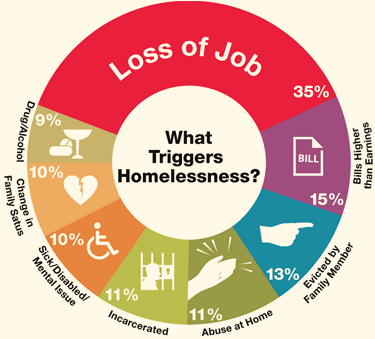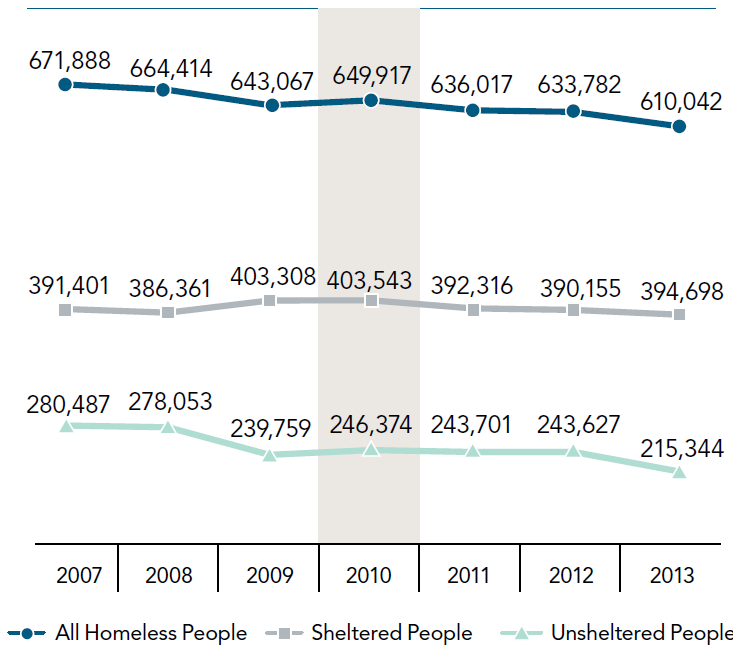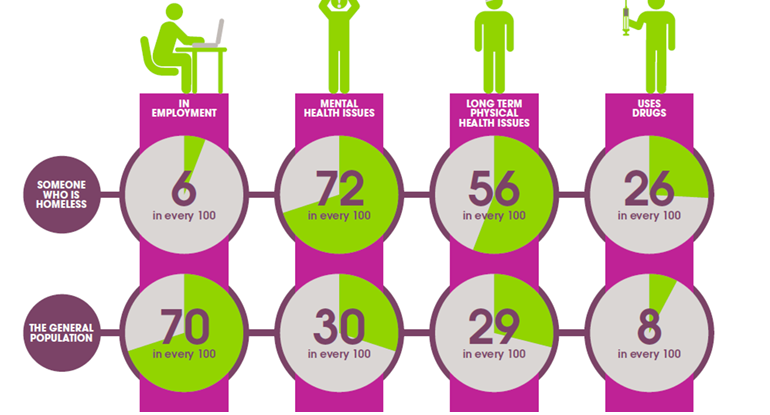Homelessness: A Problem with Data but Few Solutions
A while ago I had the pleasure to visit Strasbourg, the capital of the Alsace region and home of the European parliament. Strasbourg is a lovely city to spend a few days, go shopping, enjoy French and Alsatian cuisine, and take in the scenery, most notably the picturesque Petite France area with its half-timbered houses and restaurants serving local delicacies along the river Ill.
The story I want to tell has very little to do with Strasbourg though. It is about homelessness, statistics on homelessness, and more to the point: the lack of action by our governments to solve the problem of homelessness.
The reason I mention Strasbourg is that on the corner of Rue des Hallebardes and Rue des Orfèvres I noticed a woman, probably 25 to 30 years of age, with a well-kept dog, resting on a blanket and leaning against the wall of a shop. A note in front of the woman indicated that she was homeless and required sustenance. Ashamed of myself and my reluctance to offer any assistance to the less fortunate in society, I scuffled down Rue des Orfèvres in search of delicious chocolates and biscuits, temporarily banishing what I had just seen from my thoughts. Nevertheless, the sad image of the young woman and her faithful companion had already been seared on my mind’s eye. My biased notion of a homeless person included rough, elderly men with beards and often physical disabilities. The idea of a young woman who by any measure should be in the prime of her life with most of it probably still ahead of her did not fit into that misguided concept of homelessness.
After the trip to France I started to look into what commonly causes people to live on the streets, triggered of course by the unshakeable image of the homeless woman and her pet. Obvious reasons such as loss of employment and eviction were among the top three. Beyond that I found (actionable) data that surprised me and a lack of action that appalled me.
Causes of Homelessness
People lose their homes for various reasons. A breakdown of the causes is shown in the chart below, which is taken from The Coalition for the Homeless of Houston and is based on data from the National Alliance to End Homelessness. It is important to note that there generally is no single cause for a person to end up living on the streets; at least I hope that’s what the chart tries to convey, since the percentages add up to 114%…

Unemployment is by far the most prevalent reason. The second most important cause is underemployment or a lack of sufficient income and/or a lack of affordable housing. Hence, half of all homeless have become so because of problems with employment.
Governments tend to be fully aware of a person’s employment status because when people are unemployed they either register as unemployed to collect benefits or they stop paying taxes because they have no income. Similarly, when people cannot pay their bills any longer, credit bureaus are notified because one’s inability to pay the bills affects a person’s credit risk.
Eviction and abuse form the next slice of the pie chart with 24%. Abuse often goes unnoticed as the victims avoid reporting it to the authorities because the victims believe it may make an already bad situation even worse. These unreported cases may therefore be hard to identify on a grand scale.
Health issues, such as disabilities, mental health problems, and drug and/or alcohol abuse contribute 19%. Most civilized nations have centralized health care systems, which means that the authorities can be made aware of the situation. Sure, not every disabled man or woman with schizophrenia is at risk of becoming homeless. What I am getting at, though, is that a combination of factors can hint at an increased risk of homelessness.
Being a data person I first look at data for possible solutions. The thing I find most surprising is that a lot of the data that could be used to prevent homelessness is available to governmental institutions, yet precious little is done with it.
I fully understand that the homeless are not voters who boost a politician’s standing in a constituency, they are not a target market that companies can tap in to and capitalize on, they do not bump a country’s GDP, and so on. But judging from the amount of perfectly usable ‘waste’ we carelessly throw away each day, we can afford to help the homeless. Actually, we cannot afford not to help them and still be able to call our society a society.
Incarceration is next at 11%. I do not think I have to repeat myself: the information about a person’s status of imprisonment is available to governments. In fact, prisons are facilities run by the state.
When a person breaks up or separates from a partner that too can trigger homelessness, at least for 10% of the people who end up being homeless. Changes in the status of officially registered partnerships and married couples will result in changes in some central databases. The percentage of people in relationships who do not register their marriage or civil union is roughly 15%, which leaves approximately 8.5% of homeless cases that could be automatically monitored. For the estimate I looked at data from the US Census Bureau from 2010, in particular the percentage of unmarried partner households (6.6%) in relation to the percentage of opposite-sex family households (48.4%); the number of single households was 18.1%, and a total of 33.6% of the population were in so-called non-family households, which includes not only households of unmarried partners but also flatmates.
Anyway, if you have kept score, you’ll notice that about 88.5% out of 114%, that is 77.6% overall, is covered by data that is available or at least accessible to governmental agencies. That, in my opinion, a whopper of a number!
Statistics on the Homeless
Who are the homeless?
The answer depends very much on the country you look at. In the USA there are many veterans among adult homeless: 12.3%, of whom 92.3% are male. In countries that do not have such a grand military presence across the globe the number is obviously much smaller.
A breakdown of the homeless and the overall trend with absolute figures are shown below.


Clearly there is a downward trend, which is good news. The bad news is that families with children are “the fastest-growing segment of the homeless population”. Moreover, the mortality of the homeless, adjusted for age, is four times as high as that of the general population; the average lifespan of the homeless is shorter than 45 years. Half of all women who are homeless have fled their homes because of domestic violence. In the UK, 26% of people who accessed services for the homeless are female.

Whatever the causes of mental health problems, most sufferers do not care. What is clear, though, is that living on the streets is, rather unexpectedly, distressing and aggravates mental health issues: mental health problems are the cause of homelessness for less than 10% of the homeless, yet 72% of the homeless (in the UK) have mental health issues, as can be seen in the chart above. The Guardian noted a little while back that homelessness has become a public health crisis in the UK.
Mental health problems may not be the leading cause but they are commonplace once people live on the streets: homelessness is in most instances a cul-de-sac. There are very few statistics on the reintegration of the homeless into society; the Homeless Veterans’ Reintegration Project (HVRP) in the US offers no statistics on success rates at all. A small-scale study in Madrid from 2001 found that “homeless in situations of serious psychosocial deterioration and marginalization can live in a normal and dignified way in the community if they are given the appropriate attention and flexible support”. However, in another study in Milan six years later the conclusion is that “most continue facing problems and in several cases the independence achieved was limited”.
The chart below shows the overlap of various social issues in the UK. It clearly shows that almost half of the homeless have been or are involved in institutional care, substance abuse, and gangs. While substance abuse and street culture activities may be hard to monitor, institutional care, again, is not.

Outlook
Once you’re homeless, you’re pretty much on your own. Since we know the causes, isn’t that all the more reason to try and put an end to it? It’s not like we have no clue what causes it and are thus left with fighting the symptoms. We know the reasons, we understand the problem, yet we do precious little about it. Medscape justly notes that “homelessness is largely ignored by the mainstream press and the general public.” The recession has obviously not helped the situation. As a matter of fact, Medscape also points out that 20% of the homeless have jobs. Surely, the idea of employment is that people can afford a roof over their heads.
The homeless are not a target market for companies, so no one except governments, charitable NGOs, and interested sociologists is expected to research the extent of the problem. Homelessness does not seem to be high on the agenda of most governments. Again, I understand that there are other pressing matters governments must attend to. This is, however, a pattern that I have seen with organizations with regard to data governance too, and it’s a tough cycle to escape without the will to do it. It’s very easy to shove the problem onto your successor’s desk and say you’ve looked into it.
The raison d’être for governments is to protect society and its values. The vulnerable are our moral responsibility too. What I consider probably the worst in what I have and haven’t seen while researching homelessness is that we know the major causes, quite clearly, and yet we do nothing as societies. We could identify individuals who are at risk of becoming homeless based on information that is available to most governments in developed nations: income, family members, medical information regarding abuse, drug use and alcoholism, police records, and so on.
The UK has recently drafted a plan for data integration to increase data sharing among governmental bodies in order to fight fraud. The article mentions that the “proposals […] are designed to ensure that benefit data from the Department for Work and Pensions is more closely matched with information from the Home Office and the police, including criminal records, passports and driving licences.” The data sharing plan “could help monitor population movements, identify troubled families and elderly people in need of support [italics added].” Yes, fraud is an important issue that needs to be addressed, but the same data could do so much more: it is important that people are flagged as being at risk of becoming homeless as soon as possible, because once you’re off the government’s radar you’re pretty much invisible.
I am starting to sound like a broken record but you have to see the problem clearly before you can attempt to fix it: without quality data there is very little hope. Homelessness, its roots, and its consequences are all very clear. NGOs in many countries have mapped the problem pretty extensively. No additional inquiries are required. All governments have to do is act on the data available in their own systems.
The next time I go to Strasbourg I hope to see the young woman and her dog again. After what I’ve seen of the statistics on homelessness, I’m sure I’ll not make the same mistake again and look the other way. What I really hope, though, is that I see her walking her dog, carrying a few shopping bags on her way home, just like me.